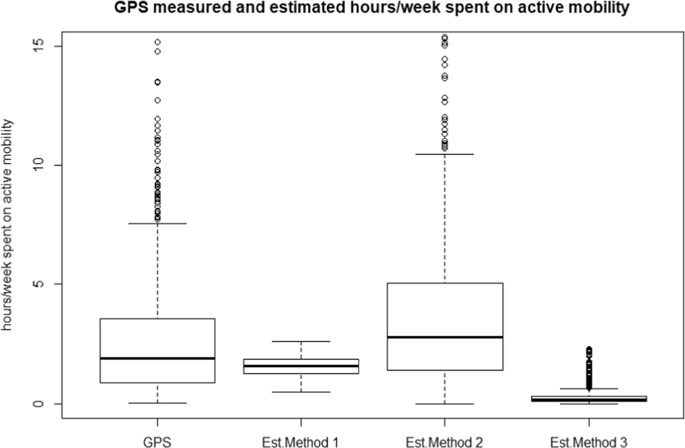Journal of Exposure Science and Environmental Epidemiology ( IF 4.1 ) Pub Date : 2019-11-26 , DOI: 10.1038/s41370-019-0194-6 Gijs Klous , Mirjam E. E. Kretzschmar , Roel A. Coutinho , Dick J. J. Heederik , Anke Huss

|
Background/aim
Active mobility may play a relevant role in the assessment of environmental exposures (e.g. traffic-related air pollution, livestock emissions), but data about actual mobility patterns are work intensive to collect, especially in large study populations, therefore estimation methods for active mobility may be relevant for exposure assessment in different types of studies. We previously collected mobility patterns in a group of 941 participants in a rural setting in the Netherlands, using week-long GPS tracking. We had information regarding personal characteristics, self-reported data regarding weekly mobility patterns and spatial characteristics. The goal of this study was to develop versatile estimates of active mobility, test their accuracy using GPS measurements and explore the implications for exposure assessment studies.
Methods
We estimated hours/week spent on active mobility based on personal characteristics (e.g. age, sex, pre-existing conditions), self-reported data (e.g. hours spent commuting per bike) or spatial predictors such as home and work address. Estimated hours/week spent on active mobility were compared with GPS measured hours/week, using linear regression and kappa statistics.
Results
Estimated and measured hours/week spent on active mobility had low correspondence, even the best predicting estimation method based on self-reported data, resulted in a R2 of 0.09 and Cohen’s kappa of 0.07. A visual check indicated that, although predicted routes to work appeared to match GPS measured tracks, only a small proportion of active mobility was captured in this way, thus resulting in a low validity of overall predicted active mobility.
Conclusions
We were unable to develop a method that could accurately estimate active mobility, the best performing method was based on detailed self-reported information but still resulted in low correspondence. For future studies aiming to evaluate the contribution of home-work traffic to exposure, applying spatial predictors may be appropriate. Measurements still represent the best possible tool to evaluate mobility patterns.
中文翻译:

农村人口主动流动的预测:三种不同方法的发展和有效性测试
背景/目的
主动出行在评估环境暴露(例如与交通有关的空气污染,牲畜排放)方面可能起着重要作用,但是有关实际出行方式的数据需要大量收集,特别是在大量研究人群中,因此,主动出行的估算方法可能与不同类型研究中的暴露评估相关。我们之前使用一周的GPS跟踪功能,在荷兰农村地区的941名参与者中收集了出行方式。我们获得了有关个人特征的信息,有关每周出行方式和空间特征的自我报告数据。这项研究的目的是开发主动运动的通用估计,使用GPS测量来测试其准确性,并探索对暴露评估研究的意义。
方法
我们根据个人特征(例如年龄,性别,既存条件),自我报告的数据(例如每辆自行车上下班花费的时间)或空间预测因素(例如住所和工作地点)来估算主动运动所花费的小时/周数。使用线性回归和kappa统计,将估计的每周活动时间/每周与GPS测量的小时/周进行比较。
结果
估计和测得的每周运动时数与星期之间的对应度很低,即使是基于自我报告数据的最佳预测估计方法,其R 2值为0.09,Cohenκ值为0.07。目视检查表明,尽管预测的工作路线似乎与GPS测量的轨迹相匹配,但是以这种方式捕获的主动活动性只占一小部分,因此导致总体预测活动性活动的有效性较低。
结论
我们无法开发一种能够准确估算主动出行能力的方法,效果最好的方法是基于详细的自我报告信息,但仍然导致对应性较低。对于旨在评估家庭作业流量对暴露的贡献的未来研究,应用空间预测因子可能是合适的。测量仍然是评估流动性模式的最佳工具。











































 京公网安备 11010802027423号
京公网安备 11010802027423号